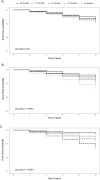Effectiveness of Z-score of log-transformed A Body Shape Index (LBSIZ) in predicting cardiovascular disease in Korea: the Korean Genome and Epidemiology Study
- PMID: 30108276
- PMCID: PMC6092353
- DOI: 10.1038/s41598-018-30600-9
Effectiveness of Z-score of log-transformed A Body Shape Index (LBSIZ) in predicting cardiovascular disease in Korea: the Korean Genome and Epidemiology Study
Abstract
Body mass index (BMI) and waist circumference (WC) have limitations in stratifying cardio-metabolic risks. Another obesity measure, A Body Shape Index (ABSI), has been introduced but its applicability remains limited. To address this, the z-score of the log-transformed ABSI (LBSIZ) was recently developed. This study aimed to examine the ability of LBSIZ, compared to that of WC and BMI, to predict cardiovascular disease (CVD) risk. The study included 8,485 participants aged 40-69 years (mean age = 52.1) who were followed for 10 years and recruited from the Korean Genome and Epidemiology Study, a population-based cohort study. The area under the curve was 0.635 (95% confidence interval [CI]: 0.614-0.657) for LBSIZ, 0.604 (95%CI: 0.580-0.627) for WC, and 0.538 (95%CI: 0.514-0.562) for BMI. The AUC of the Framingham risk score (FRS) was 0.680 (95%CI: 0.659-0.701) in comparison. When we added LBSIZ to the model, the integrated AUC significantly improved from 0.680 to 0.692 (95%CI: 0.672-0.713; p value, 0.033), whereas there were no changes with BMI (AUC, 0.678; 95%CI: 0.656-0.699) or WC (AUC, 0.679; 95%CI: 0.658-0.701). In the multivariate Cox regression analysis, LBSIZ but not BMI or WC showed a significant hazard ratio of CVD event compared to 1st decile of each parameter. In the restricted cubic spline regression, BMI and WC showed an overall J-shaped relationship with CVD events whereas LBSIZ showed a linear relationship. LBSIZ is strongly associated with CVD risk and should predict CVD risk better than BMI and WC in the general population.
Conflict of interest statement
The authors declare no competing interests.
Figures




Similar articles
-
Effect of body shape on the development of cardiovascular disease in individuals with metabolically healthy obesity.Medicine (Baltimore). 2020 Sep 18;99(38):e22036. doi: 10.1097/MD.0000000000022036. Medicine (Baltimore). 2020. PMID: 32957321 Free PMC article.
-
Utility of the Z-score of log-transformed A Body Shape Index (LBSIZ) in the assessment for sarcopenic obesity and cardiovascular disease risk in the United States.Sci Rep. 2019 Jun 26;9(1):9292. doi: 10.1038/s41598-019-45717-8. Sci Rep. 2019. PMID: 31243316 Free PMC article.
-
The Association between Z-Score of Log-Transformed A Body Shape Index and Cardiovascular Disease in Korea.Diabetes Metab J. 2019 Oct;43(5):675-682. doi: 10.4093/dmj.2018.0169. Epub 2019 Apr 26. Diabetes Metab J. 2019. PMID: 31237130 Free PMC article.
-
Association of a New Measure of Obesity with Hypertension and Health-Related Quality of Life.PLoS One. 2016 May 16;11(5):e0155399. doi: 10.1371/journal.pone.0155399. eCollection 2016. PLoS One. 2016. PMID: 27183311 Free PMC article.
-
Untangling Waist Circumference and Hip Circumference from Body Mass Index with a Body Shape Index, Hip Index, and Anthropometric Risk Indicator.Metab Syndr Relat Disord. 2018 May;16(4):160-165. doi: 10.1089/met.2017.0166. Epub 2018 Mar 13. Metab Syndr Relat Disord. 2018. PMID: 29649376 Review.
Cited by
-
Association of Body Shape Index (ABSI) with Hand Grip Strength.Int J Environ Res Public Health. 2020 Sep 17;17(18):6797. doi: 10.3390/ijerph17186797. Int J Environ Res Public Health. 2020. PMID: 32957738 Free PMC article.
-
Effect of body shape on the development of cardiovascular disease in individuals with metabolically healthy obesity.Medicine (Baltimore). 2020 Sep 18;99(38):e22036. doi: 10.1097/MD.0000000000022036. Medicine (Baltimore). 2020. PMID: 32957321 Free PMC article.
-
Association between body shape index and risk of mortality in the United States.Sci Rep. 2022 Jul 4;12(1):11254. doi: 10.1038/s41598-022-15015-x. Sci Rep. 2022. PMID: 35788633 Free PMC article.
-
Associations of four obesity indices with diabetes mellitus in Korean middle-aged and older adults using the Korean Genome and Epidemiology Study (KoGES).BMC Public Health. 2025 Feb 5;25(1):473. doi: 10.1186/s12889-025-21567-0. BMC Public Health. 2025. PMID: 39910521 Free PMC article.
-
Utility of the Z-score of log-transformed A Body Shape Index (LBSIZ) in the assessment for sarcopenic obesity and cardiovascular disease risk in the United States.Sci Rep. 2019 Jun 26;9(1):9292. doi: 10.1038/s41598-019-45717-8. Sci Rep. 2019. PMID: 31243316 Free PMC article.
References
-
- World Health Organization. Global Health Risks: Mortality and Burden of Disease Attributable to Selected Major Risks (WHO Press, 2009).
-
- Korean Statistical Information Service. Prevalence of obesity in Korea http://kosis.kr/statHtml/statHtml.do?orgId=117&tblId=DT_11702_N101# (2018).
Publication types
MeSH terms
LinkOut - more resources
Full Text Sources
Other Literature Sources
Medical

